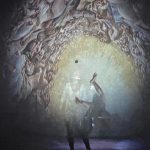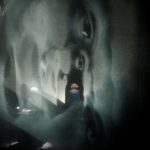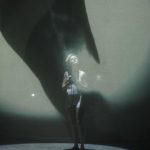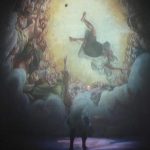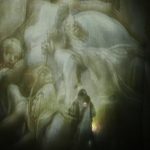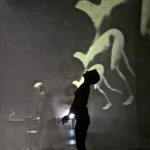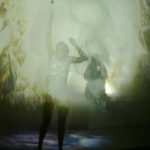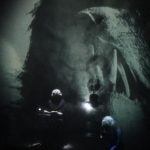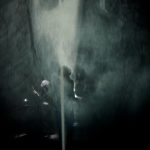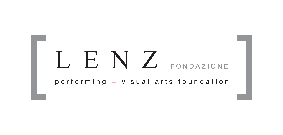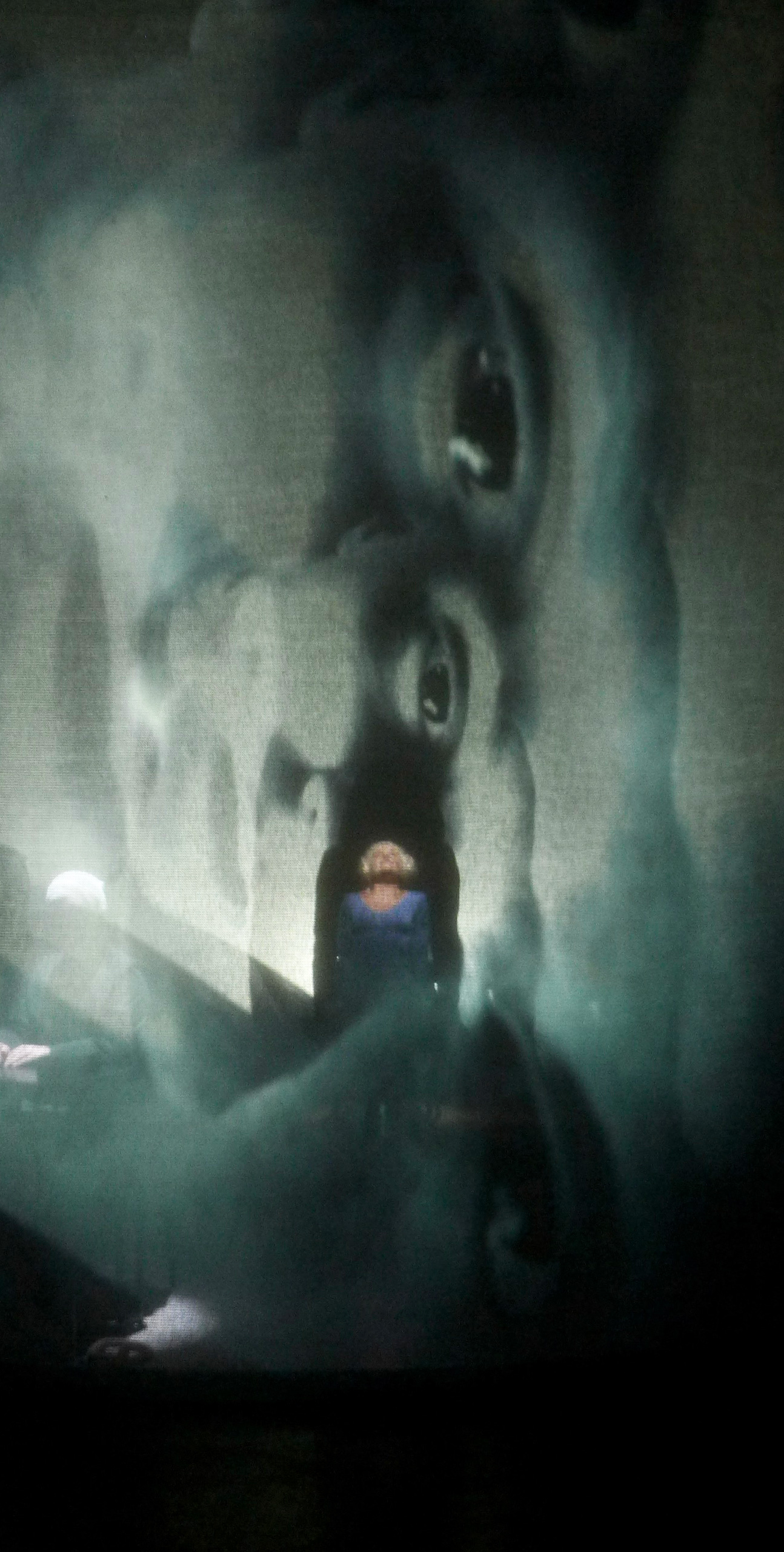
LA CREAZIONE (The Creation)
Maria Federica Maestri and Francesco Pititto direct Valentina Barbarini and the soprano Debora Tresanini in a meditation in front of the mystery of the Beginning, immersed in the work of Franz Joseph Haydn – Die Schöpfung – and inspired by the sound writing of Andrea Azzali.
Ancient obscure eloquences, romantic evocations of a lost nature, contemporary scientific intuitions, compose the great fresco of paintings and psychic states of La Creazione [The Creation], performative, sound and image writing inspired by the texts of Genesis, the Psalms and the poem Paradise lost by John Milton. Visions and words that proceed by flashes of reversed memory: from verse 27 that concludes the first account of biblical Genesis ‘And God created man in his image’ to the first verse ‘In the beginning God created heaven and earth’. A backward movement interpreted by two scenic figures, the Theologian and the Scientist, called to prove the existence of the initial One and to find residual traces of it in the creative present.
La Creazione by Lenz Fondazione is among the winners of the project Vivere all’italiana sul palcoscenico [Living Italian style on stage], promoted by the Italian Ministry of Foreign Affairs and International Cooperation – General Directorate for the Promotion of the Country System in collaboration with the General Directorate for Entertainment of the Italian Ministry for Cultural Heritage and Activities and for Tourism, aimed at enhancing innovative Italian artistic projects.
LA CREAZIONE [The Creation]
GENESIS THE BIBLE PARADISE LOST – HORIZON OF EVENTS
Was there a time before the beginning of time?
«It was getting close to nothingness, but it was never nothing, there was never a Big Bang that produced something out of nothing. It only seems so from a human perspective». Stephen W. Hawking
«Time does not exist, it is only a dimension of the soul. The past does not exist because it is no longer, the future does not exist because it has yet to be, and the present is only a non-existent moment of separation between past and future. Saint Augustine
«Often, when I am struggling with obstacles of all kinds, when my strength declines and it has become difficult for me to persevere on the path I have taken, a secret feeling whispers to me: there are so few men down here who are happy and content, everywhere is pain and anguish; perhaps your work can sometimes be a source from which those oppressed by anguish can draw relief for a moment». Franz Joseph Haydn
The strong visual, almost cinematic impact of Haydn’s Die Schöpfung score, which between recitatives, arias, ensemble pieces and choirs leads to original orchestral explosions, the appearance of the first light, the precise description of Nature and animals, the poetic love duets of Adam and Eve until the final thanksgiving to God, all this linguistic chaos, including Beethoven’s powerful effects and Mozart’s refinements, makes Haydn’s “The Creation” an absolutely contemporary work. The figures – the Archangels, Adam and Eve – are the bearers of countless linguistic stimuli. Moreover, the themes developed are still present, precisely because they are timeless, in contemporary art and culture. To relate the limit of the “human perspective”, the human dimension of time and the latest scientific research on the origin of the Universe, or universes, and the appearance of the first man and woman on Earth is a dramaturgical subject of considerable interest and complexity. However, like scientific and theological research, we think that artistic research can contribute to develop new horizons of knowledge, of deep intellectual experience both through the experience of the concrete act and through the music of singing.
Just as crossing the biblical sequence of Genesis to Adam and Eve and at the same time reflecting it the poetic alter ego in Milton’s Paradise Lost, with Satan’s gaze and strategy for the time to come becomes an accelerator of the dramatic dynamic – with his angels in the midst of hell, not in the center of the world because heaven and earth were not there yet, but in a place of darkness called Chaos – therefore a double chaos that, like two spinning black holes collide in a cosmic duel of infinite power, give rise to a spinning abyss as big as billions of suns.
To then stop time, clearing it together with space, on the horizon of events.
A whirlwind of verses, repetitions, lamentations, linear and labyrinthine directions with only the instruments of the body, of music, of images. From free will to the sin of origin, Haydn’s oratory breaks down into a granular structure that projects itself into scenic space like fragments of atoms, pieces of stars and planets not yet composed, in a movement of sound expansion like a cosmic wave that we still do not hear but that we begin to glimpse.
Creating is a verb that belongs to art, where everything is created from the void that everything contains, where every human act hooks into thought and at the same time projects into space infinite variables of meaning and relations at a distance.
The only ‘space-time’, for theater, is the one that begins and ends with the time of representation, three-dimensional and geometrically corporeal. It can contain as the origin of everything the appearances of other worlds, through images and music as well as thoughts, feelings, refractions. The gravity that keeps the actors with their feet on the ground counterbalances the ‘weightlessness’ of words, movements, symbols.
The creation of everything, from the linear precipitation to that insignificant deviation of only one of the infinite atoms that changes things, the present and the future, implodes in a dramaturgy that attracts biblical legends, baroque poems, mathematical formulas in a sequence of events that has as its end the demonstration of different possibilities, the freedom of error, the singularity of creating and recreating the world, from big bang to big bang to infinity.
Gravity holds everything, even time implodes in everyone’s memory, from now down to the first memory. It can be this inverse direction to lead the dramaturgical game, a text backwards, from the end to the beginning, from now until the first almost imperceptible listening to a voice, a noise, a sound. From Adam and Eve sink to the point where it all begins, and from there to the unknowable irrelevant to science, at least for now.
And the verses fall, collide with other verses, images, actions, singing and sound recreating a chaotic overall movement, imprisoned in the time of the ritual that recreates creation.
IMAGOTURGY OF LA CREAZIONE [THE CREATION]
The images show a time imploding, like the angel looking at us falling backwards or falling upwards, like the galaxies that show themselves as they were billions of years ago, like a reversal of the linearity that proceeds towards the appearance of the first face, from the chaos of the first day.
First the face, then an upturned dawn that has already set, the first filiform matter, the first vegetables, the first vertebrates, life that begins to fly, the creation of the first man and the first woman, the flight of the blessed angels and that of the fallen angels.
Then the return, the relapse into amniotic fluid, inside a warm and nourishing belly of a maternal space that all sucks, reduces, concentrates. Up to that black spot, always present in every macro or microcosm of falling atoms, in every vital instant, up to the incalculable dimension before the new beginning. Of new universes.
They are images already present, already born, among the million of billions of synapses of the brain, as among the similar billions of galaxies and stars of the universe, interconnected and rapid, superimposed blurred sequences that swallow the live action of singing and words.
Crystal images inside a bubble of meaning, inside a beginning of all beginnings, like a contemporary Welles’ Rosebud of infinite memory.
The transparent and semicircular double veil of the scene hosts the image, it contains it and curves it as space-time bends to the mass of bodies, in the four-dimensional scene where time fluctuates between a before and an after, and at the same time matter and image fluctuate between past and present.
THE INSTANT OF THE SNAPSHOT. The flash, the lightning and then the matter in progress that comes out of its shell. The chemical progression, in action with light and temperature, makes the form impressed on the sensitive layer grow, revealing it in a crescendo of crystalline pigments and thermal process.
In a moment the light introduces the virtual, through the grid hole that tightens and directs the access, the formless hidden in the dark magma of the revealing solution.
Snapshot of the instant, the real doubles and reappears alchemic and unique, on the mirror of the virtual. The time previously imprisoned, spreads on the paper layer together with the reagent, it delays its end, and by extinguishing itself drying it makes the image rise from the real world.
NAIL FILING, STARDUST. These billions of billions of atoms are intergalactic matter, it comes from cosmic distances of thousands of light-years and finally merged, reunited, compressed by its own gravity.
Stars are inside us, nitrogen in our DNA, calcium in our teeth, iron in our blood, compact keratin in our nails.
The dust of the filed nail is human matter and cosmic matter, like the dust of bodies destined to close the circle of mortal time, dust to dust, dust of dust.
Isn’t like that the beginning, isn’t like that before the beginning?
LA CREAZIONE [The Creation] Original text by Francesco Pititto from ‘The Creation’ by Franz Joseph Haydn and from the texts of Genesis, Psalms and Paradise lost by John Milton
Writing, dramaturgy, imagoturgy | Francesco Pititto
Installation, direction, costumes | Maria Federica Maestri
Performers | Valentina Barbarini, Debora Tresanini soprano
Music | Franz Joseph Haydn, Andrea Azzali
Voice over | Agata Pelosi
Curator | Elena Sorbi
Organization | Ilaria Stocchi
Promotion and communication | Michele Pascarella
Video subtitles translation | Cecilia Rosso
Technical curators | Alice Scartapacchio, Lucia Manghi
Training | Loredana Scianna
Technical assistant | Marco Cavellini
Media video | Andrea Pizzalis, Riccardo Roberti
Production | Lenz Fondazione
Duration | 50 minutes







